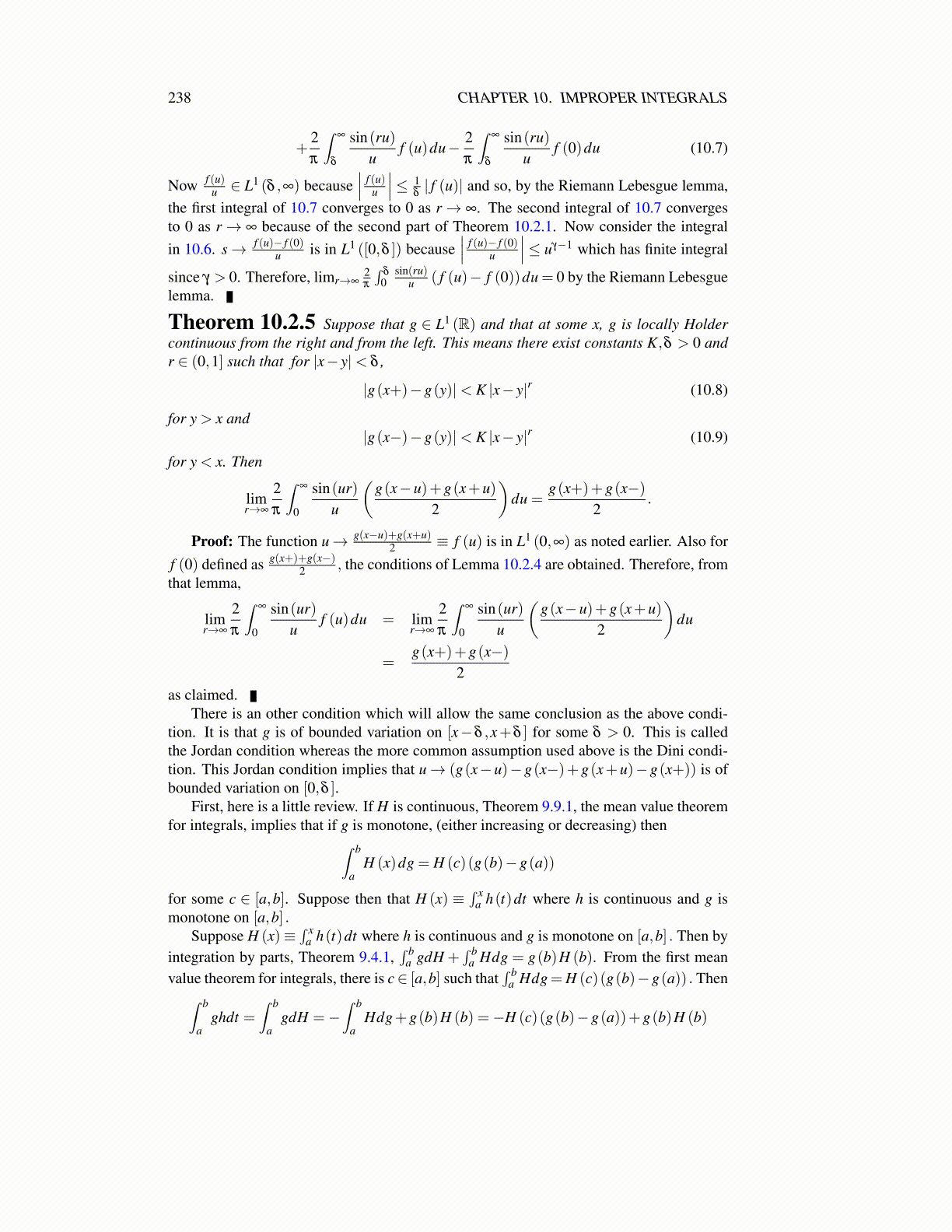
238 CHAPTER 10. IMPROPER INTEGRALS
Now consider g(0+) I2. It equals g(0+) 2π
∫ rh0
sin(u)u du so its limit as r→ ∞ is g(0+).
It is just the Dirichlet integral again.Finally, consider I3. For t ≥ h, g(t)
t is in L1 (h,a) and so, the 0 extension off [h,∞) is inL1 ([0,a)) . By the Riemann Lebesgue lemma, of Theorem 10.2.1, this integral I3 convergesto 0 as r→ ∞.
With this, here is a different version of Theorem 10.2.5.
Corollary 10.2.8 Suppose that g ∈ L1 (R) and that at some x, g is of finite total varia-tion on [x−δ ,x+δ ] for some δ > 0. Then
limr→∞
2π
∫∞
0
sin(ur)u
(g(x−u)+g(x+u)
2
)du =
g(x+)+g(x−)2
.
Proof: This follows from Lemma 10.2.7 applied to u→ g(x−u)+g(x+u)2 .
10.3 The Gamma FunctionRecall the definition of an improper integral specialized to (0,∞). You let an ↓ 0,bn ↑ ∞
and∫
∞
0 f (t)dt = limn→∞
∫ bnan
f (t)dt.
Definition 10.3.1 Whenever α > 0, Γ(α)≡∫
∞
0 e−ttα−1 dt.
Lemma 10.3.2 The improper integral∫
∞
0 e−ttα−1 dt exists for each α > 0.
Proof: Let f (t) ={
tα−1 if t ≤ 1Ce−t/2 if t > 1
where C is chosen large enough that for t >
1,Ce−t/2 > e−ttα−1. Then obviously f ∈ L1 (0,∞) and f (t) ≥ e−ttα−1. Also, if [α,β ] ⊆(0,∞) , ∫
β
α
e−ttα−1 dt ≤∫
∞
0f (t)dt < ∞
and so t → e−ttα−1 is in L1 (0,∞) so the improper integral exists as claimed thanks toProposition 10.0.2.
This gamma function has some fundamental properties described in the following pro-position. In case the improper integral exists, we can obviously compute it in the formlimδ→0+
∫ 1/δ
δf (t)dt which is used in what follows. Thus also the usual algebraic proper-
ties of the Riemann integral are inherited by the improper integral.
Proposition 10.3.3 For n a positive integer, n! = Γ(n+1). In general, one has thefollowing identity: Γ(1) = 1,Γ(α +1) = αΓ(α)
Proof: First of all, Γ(1) = limδ→0∫
δ−1
δe−tdt = limδ→0
(e−δ − e−(δ
−1))= 1. Next,
for α > 0,
Γ(α +1) = limδ→0
∫δ−1
δ
e−ttα dt = limδ→0
[−e−ttα |δ
−1
δ+α
∫δ−1
δ
e−ttα−1dt
]
= limδ→0
(e−δ
δα − e−(δ
−1)δ−α +α
∫δ−1
δ
e−ttα−1dt
)= αΓ(α)